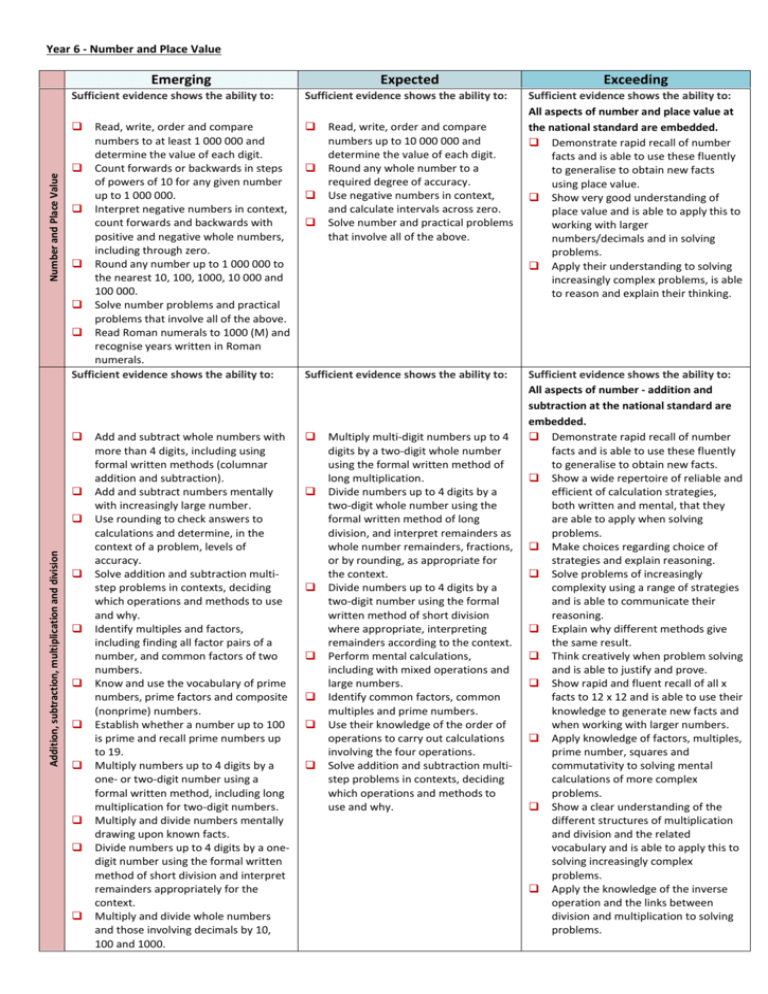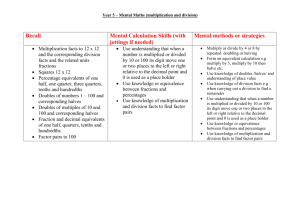Y6 number
advertisement

Year 6 - Number and Place Value Number and Place Value Emerging Sufficient evidence shows the ability to: Sufficient evidence shows the ability to: Read, write, order and compare numbers to at least 1 000 000 and determine the value of each digit. Count forwards or backwards in steps of powers of 10 for any given number up to 1 000 000. Interpret negative numbers in context, count forwards and backwards with positive and negative whole numbers, including through zero. Round any number up to 1 000 000 to the nearest 10, 100, 1000, 10 000 and 100 000. Solve number problems and practical problems that involve all of the above. Read Roman numerals to 1000 (M) and recognise years written in Roman numerals. Sufficient evidence shows the ability to: Addition, subtraction, multiplication and division Expected Add and subtract whole numbers with more than 4 digits, including using formal written methods (columnar addition and subtraction). Add and subtract numbers mentally with increasingly large number. Use rounding to check answers to calculations and determine, in the context of a problem, levels of accuracy. Solve addition and subtraction multistep problems in contexts, deciding which operations and methods to use and why. Identify multiples and factors, including finding all factor pairs of a number, and common factors of two numbers. Know and use the vocabulary of prime numbers, prime factors and composite (nonprime) numbers. Establish whether a number up to 100 is prime and recall prime numbers up to 19. Multiply numbers up to 4 digits by a one- or two-digit number using a formal written method, including long multiplication for two-digit numbers. Multiply and divide numbers mentally drawing upon known facts. Divide numbers up to 4 digits by a onedigit number using the formal written method of short division and interpret remainders appropriately for the context. Multiply and divide whole numbers and those involving decimals by 10, 100 and 1000. Read, write, order and compare numbers up to 10 000 000 and determine the value of each digit. Round any whole number to a required degree of accuracy. Use negative numbers in context, and calculate intervals across zero. Solve number and practical problems that involve all of the above. Sufficient evidence shows the ability to: Multiply multi-digit numbers up to 4 digits by a two-digit whole number using the formal written method of long multiplication. Divide numbers up to 4 digits by a two-digit whole number using the formal written method of long division, and interpret remainders as whole number remainders, fractions, or by rounding, as appropriate for the context. Divide numbers up to 4 digits by a two-digit number using the formal written method of short division where appropriate, interpreting remainders according to the context. Perform mental calculations, including with mixed operations and large numbers. Identify common factors, common multiples and prime numbers. Use their knowledge of the order of operations to carry out calculations involving the four operations. Solve addition and subtraction multistep problems in contexts, deciding which operations and methods to use and why. Exceeding Sufficient evidence shows the ability to: All aspects of number and place value at the national standard are embedded. Demonstrate rapid recall of number facts and is able to use these fluently to generalise to obtain new facts using place value. Show very good understanding of place value and is able to apply this to working with larger numbers/decimals and in solving problems. Apply their understanding to solving increasingly complex problems, is able to reason and explain their thinking. Sufficient evidence shows the ability to: All aspects of number - addition and subtraction at the national standard are embedded. Demonstrate rapid recall of number facts and is able to use these fluently to generalise to obtain new facts. Show a wide repertoire of reliable and efficient of calculation strategies, both written and mental, that they are able to apply when solving problems. Make choices regarding choice of strategies and explain reasoning. Solve problems of increasingly complexity using a range of strategies and is able to communicate their reasoning. Explain why different methods give the same result. Think creatively when problem solving and is able to justify and prove. Show rapid and fluent recall of all x facts to 12 x 12 and is able to use their knowledge to generate new facts and when working with larger numbers. Apply knowledge of factors, multiples, prime number, squares and commutativity to solving mental calculations of more complex problems. Show a clear understanding of the different structures of multiplication and division and the related vocabulary and is able to apply this to solving increasingly complex problems. Apply the knowledge of the inverse operation and the links between division and multiplication to solving problems. Year 6 - Number and Place Value Sufficient evidence shows the ability to: Sufficient evidence shows the ability to: Fractions Compare and order fractions whose denominators are all multiples of the same number. Identify, name and write equivalent fractions of a given fraction, represented visually, including tenths and hundredths recognise mixed numbers and improper fractions and convert from one form to the other and write mathematical statements > 1 as a mixed number [for example: 2/5 + 4/5 = 6/5 = 1 1/5]. Add and subtract fractions with the same denominator and denominators that are multiples of the same number. Multiply proper fractions and mixed numbers by whole numbers, supported by materials and diagrams. Read and write decimal numbers as fractions [for example, 0.71 = 100 71]. Recognise and use thousandths and relate them to tenths, hundredths and decimal equivalents. Round decimals with two decimal places to the nearest whole number and to one decimal place. Read, write, order and compare numbers with up to three decimal places. Solve problems involving number up to three decimal places. Ratio and proportion Recognise the per cent symbol (%) and understand that per cent relates to ‘number of parts per hundred’, and write percentages as a fraction with denominator 100, and as a decimal. Solve problems which require knowing percentage and decimal equivalents of 1/2, 1/4, 1/5 , 2/5 , 4/5 and those fractions with a denominator of a multiple of 10 or 25. Sufficient evidence shows the ability to: All aspects of number – fractions at the national standard are embedded Apply knowledge of fractions to problems involving measures and shapes. Use their knowledge of decimals in problem involving measure to work with increased accuracy. Demonstrate a very good understanding of the connections between fractions decimals and percentages and is able to use their knowledge to translate between the three. Apply their knowledge of fractions, decimals and percentages to problems of increasing complexity and to explain their reasoning and thinking. Use common factors to simplify fractions; use common multiples to express fractions in the same denomination. Compare and order fractions, including fractions > 1. Add and subtract fractions with different denominators and mixed numbers, using the concept of equivalent fractions. Multiply simple pairs of proper fractions, writing the answer in its simplest form [e.g. 1/2 × 1/2 = 1/8]. Divide proper fractions by whole numbers [e.g. 1/3 ÷ 2 = 1/6]. Associate a fraction with division and calculate decimal fraction equivalents [for example, 0.375] for a simple fraction [for example, 3/8]. Identify the value of each digit in numbers given to three decimal places and multiply and divide numbers by 10, 100 and 1000 giving answers up to three decimal places. Multiply one-digit numbers with up to two decimal places by whole numbers. Use written division methods in cases where the answer has up to two decimal places. Solve problems which require answers to be rounded to specified degrees of accuracy. Recall and use equivalences between simple fractions, decimals and percentages, including in different contexts. Solve problems involving the relative sizes of two quantities where missing values can be found by using integer multiplication and division facts. Solve problems involving the calculation of percentages [for example, of measures, and such as 15% of 360] and the use of percentages for comparison. Solve problems involving similar shapes where the scale factor is known or can be found. Solve problems involving unequal sharing and grouping using knowledge of fractions and multiples. Demonstrate a very good understanding of the connections between fractions, decimals and percentages, ratio and proportion and is able to use their knowledge to translate between the three. Apply their knowledge of ratio and proportion to problems of increasing complexity and to explain their reasoning and thinking. Year 6 - Number and Place Value algebra Use simple formula to represent calculations such as perimeter and area of different shapes. Use sequencing when working on shape, measures and pattern activities. Solve problems including missing number problems using addition, subtraction, multiplication and division facts. Demonstrate a secure understanding of the inverse relationship when applied to calculations involving two variables. Use simple formulae. Generate and describe linear number sequences. Express missing number problems algebraically Find pairs of numbers that satisfy an equation with two unknowns. Enumerate possibilities of combinations of two variables. Use algebraic representation to illustrate relationships and patterns. Apply understanding of equivalence in calculation to solve problems with unknowns and more than one possibility. Use algebra to prove relationships and patterns. Explain the meaning of the mathematical notation.





